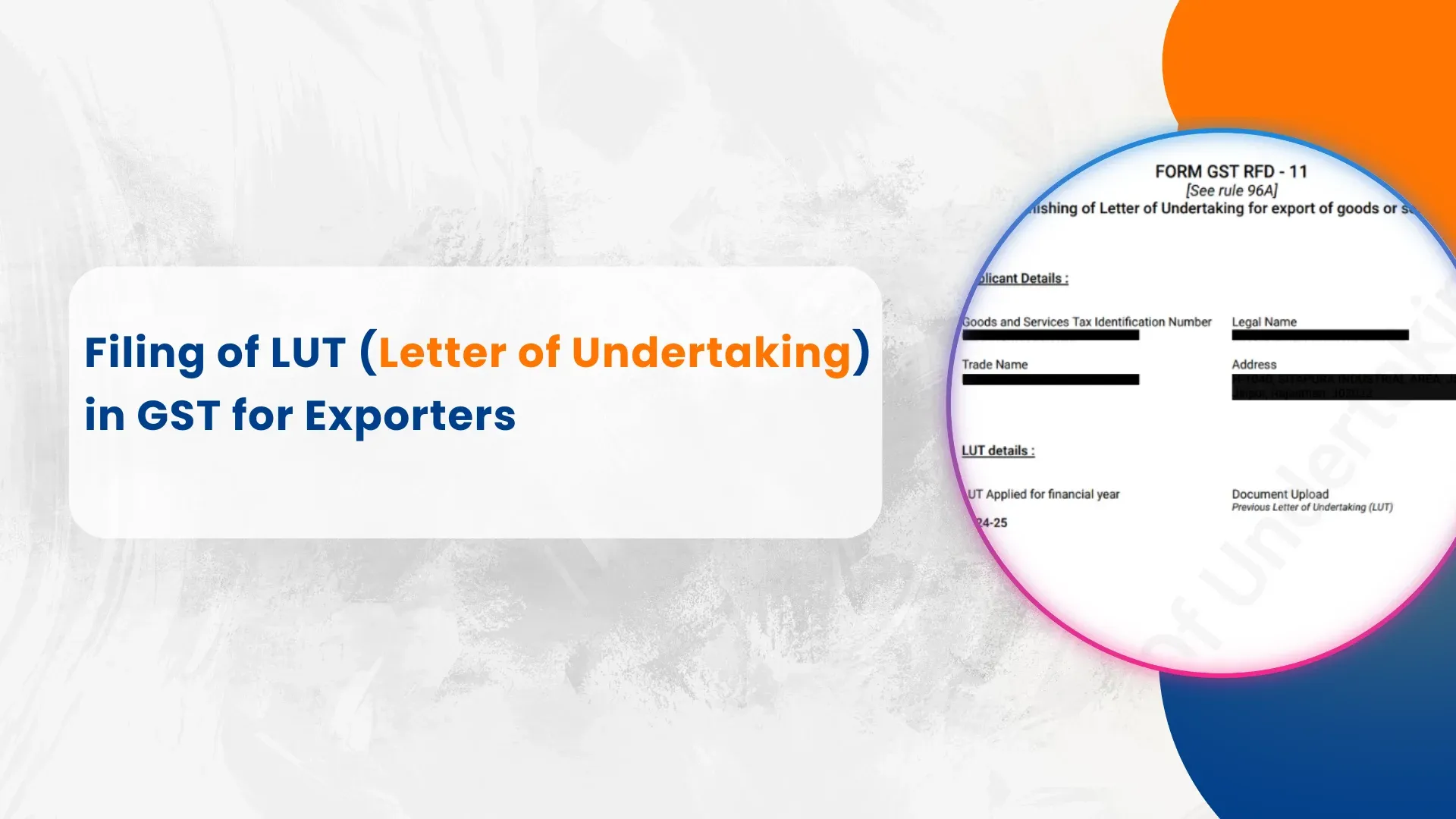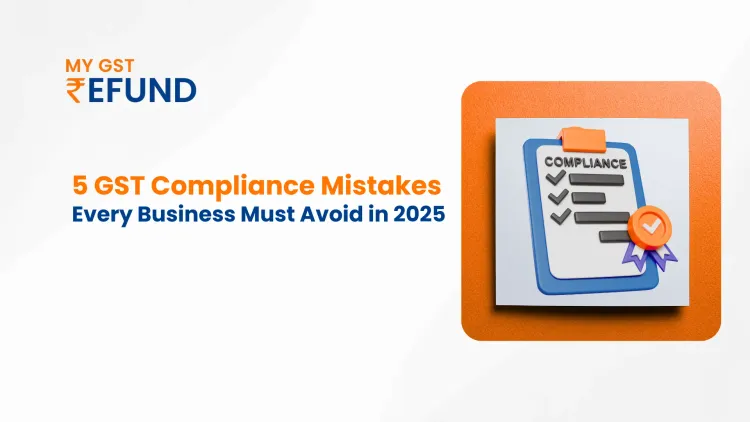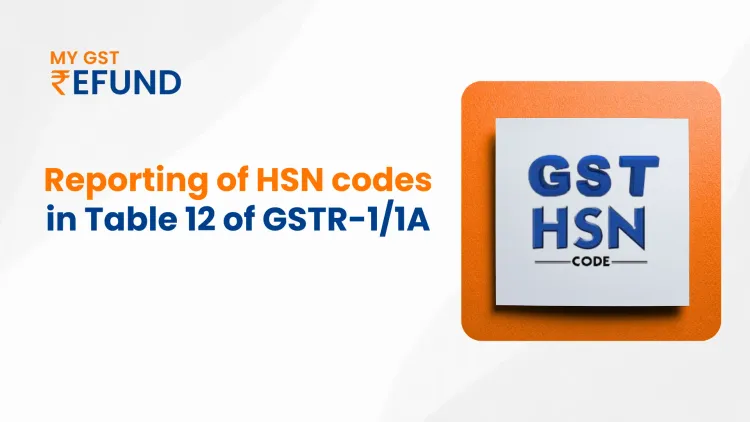Filing of LUT (Letter of Undertaking) in GST for Exporters
The economy of India cannot function without exporting goods and services. The government gives export transaction relief through the Goods and Services Tax (GST) system to make operations more efficient. A major relief program under GST regulations includes the Letter of Undertaking (LUT), which enables exporters to perform exports yet avoid Integrated Goods and Services Tax(IGST) payments. Businesses doing export activities can benefit from LUT filing under GST by reducing their burden and improving their compliance, as well as cash flow. Under this arrangement, exporters do not need to claim tax refunds because the process becomes quick and easy.
Meaning of LUT in GST
The Goods and Services Tax authorises exporters to file a document named Letter of Undertaking (LUT) for demonstrating compliance with GST requirements when exporting goods or services without paying Integrated Goods and Services Tax (IGST). During the export process, exporters no longer need to block working capital funds for tax payments or to claim future tax refunds. Through the configuration of a letter of undertaking, exporters make legally enforceable agreements to follow every law and regulation affecting GST and export activities.
Definition of LUT
A registered individual who wants to export goods without IGST payment can file an LUT according to Rule 96A of the Central Goods and Services Tax (CGST) Rules, 2017. This document serves as a substitute for the requirement of providing both an export bond as well as a bank guarantee.
Who Can File LUT?
Any registered taxpayer engaged in export activities can file an LUT if they meet the following conditions:
1. Registered Under GST:
- The business must be a GST-registered entity.
2. Exporting Goods or Services:
- The LUT applies to exporters of goods and services, as well as supplies made to Special Economic Zones (SEZs) without paying IGST.
3. No History of Tax Evasion:
- If the exporter has been prosecuted for tax evasion exceeding ₹2.5 crore, they are not eligible to file an LUT and must instead provide an export bond.
Validity of LUT
- An LUT remains valid for one financial year (April–March).
- A new LUT must be filed at the beginning of each financial year.
- If an exporter fails to fulfill the obligations mentioned in the LUT, they may be required to pay IGST along with interest.
- Failure to renew the LUT on time may result in export delays and additional compliance costs.
Benefits of Filing LUT
Export merchants benefit from multiple advantages when they file LUTs.
1. Avoids IGST Payment:
- Exporters do not need to pay IGST for exports because they can avoid the initial payment while claiming their refund at a later time.
- The process allows businesses to keep their cash flow intact by avoiding extra tax deductions through working capital maintenance.
2. Improves Cash Flow:
- The tax payment function does not lock up working capital.
- Additional business liquidity enables organisations to fund their operational areas for expansion.
3. Reduces Compliance Burden:
- The requirement for LUT filing eliminates both the amount of time and the steps involved in tax refund processes.
- The procedure enables expedited processing of export procedures.
4. Enhances Competitiveness:
- Business exporters can achieve better competitiveness through reduced expenses, together with operational efficiency improvements.
- Organisations gain access to improved market competitiveness through advertised worldwide pricing structures.
Step-by-Step Process to File LUT Online
The GST portal provides an easy process for filing LUT online. Follow these steps:
Step 1: Log in to the GST Portal
- Visit https://www.gst.gov.in/
- Enter your login credentials.
Step 2: Navigate to LUT Application
- Go to Services > User Services > Furnish Letter of Undertaking (LUT).
Step 3: Select Financial Year
- Choose the financial year for which you want to file the LUT.
Step 4: Fill in the Required Details
- Verify and update business details if necessary.
- Ensure that all fields are accurately filled.
Step 5: Upload Supporting Documents (if applicable)
- While uploading is not mandatory in most cases, supporting documents may be required in special cases.
Step 6: Sign and Submit the Form
- Use a Digital Signature Certificate (DSC) or Electronic Verification Code (EVC) to sign the LUT.
- Click Submit to complete the process.
Step 7: Download Acknowledgment
- Once submitted, an acknowledgement will be generated.
- Keep a copy for your records as proof of LUT submission.
- This document may be required during audits or compliance checks.
Documents Required for Filing LUT
- Multiple documents form the basis for LUT filing.
- GST Registration Certificate
- PAN Card of the Entity
- Authorized Signatory’s PAN & Aadhaar
- Previous Year’s LUT (if applicable)
- IEC (Import Export Code) is mutually used according to availability.
- The processing bank details for possible refund payments need to be provided.
Common Mistakes to Avoid While Filing LUT
- Pick the right financial year from the available options for your submission.
- Designed data points need to synchronise precisely with all fields present in GST registration documentation.
- Failure to Renew LUT on Time: Submit a new LUT at the start of every financial year.
Citizens should always download and keep the acknowledgement safe as a reference for future needs. - The correct Digital Signature Certificate and Electronic Virtual Certificate should be used because incorrect signatures can lead to submission errors.
Alternatives to LUT: Export Bond
- The exporter must present both an export bond and a bank guarantee to the authorities in case they do not qualify for the LUT.
- The legal guarantee establishes that exporters will follow all requirements under GST regulations.
- The bank guarantee value determines it through assessments of both exporter turnover figures along tax obligations.
Compliance After Filing LUT
After LUT registration takes place, exporters must proceed with the following steps:
1. Ensure Exports are Completed Within 3 Months
- The exported items must leave India before the invoice date reaches three months.
- If the IGST payment stays unpaid for more than three months, it usually leads to interest calculations.
2. Maintain Proper Documentation
- Proper audits require exporters to maintain documentation of their export invoices, together with their received LUT acknowledgements.
- All proof of export should be stored, including shipping bills, e-way bills, and a bill of lading.
3. Adhere to GST Rules and Regulations
- Not abiding by these rules will result in financial punishments, together with the permanent loss of LUT advantages.
- Exporters who do not follow the correct procedure must change to paying and obtaining IGST refunds.
Pro Tips: Plan Ahead and Easily Calculate Your GST Refund with Our Online GST Refund Calculator Tool!
Conclusion
GST exporters need to file a Location Upgradation Certificate because it enables them to make IGST-free exports. The LUT application through an online platform supports easy access while offering exporters improved financial health, together with reduced costs and superior market competitiveness. All exporters need to renew their LUTs on time and follow GST regulations precisely in order to avoid penalties, which might disrupt their export activities.
Through the use of the LUT facility, businesses optimise their financial efficiency, which leads to smoothness, and exporters receive long-term advantages through correct documentation practices that follow GST laws.
Frequently Asked Questions
1. Who is required to furnish a Letter of Undertaking (LUT)?
Any GST-registered taxpayer who exports goods or services or supplies to Special Economic Zones (SEZs) without paying IGST must furnish an LUT. However, businesses with a history of tax evasion exceeding ₹2.5 crore are ineligible and must furnish an export bond instead.
2. How can I file an LUT under GST?
The LUT can be filed online through the GST portal by navigating to Services > User Services > Furnish Letter of Undertaking (LUT). The form must be filled out, digitally signed, and submitted for approval.
3. What is the validity period of an LUT, and when should it be renewed?
An LUT is valid for one financial year (April to March). Exporters must renew it at the beginning of each financial year to continue exporting without paying IGST.
Read More: A Complete Guide on Input Tax Credit (ITC) Under GST with Example
Related Posts








